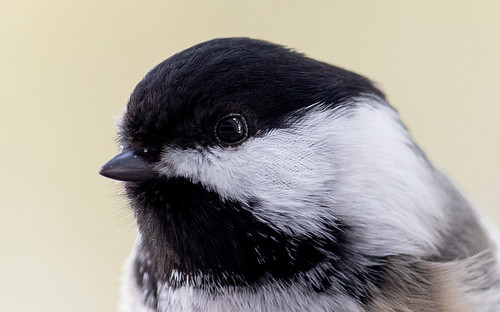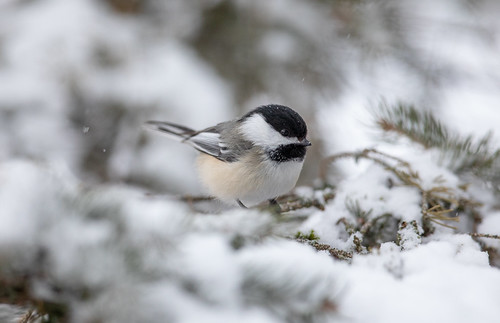My plan for today’s program was to talk about all the great owl sightings Russ and I had this year on Superb Owl Sunday. Yes, it was the coldest day of the entire season, the temperature 20 below when we got up, and yes, it didn’t get above five below all day, and yes, the wind was fierce. But there were owls out there—two Great Horned Owls hanging out somewhere in my neighborhood, and Barred and Great Gray and Northern Hawk Owls and probably even a Boreal Owl out there somewhere. It’s just that not a single one of them intersected our path. Yep—I got skunked. I don’t blame the owls for laying low—so did every other sensible warm-blooded creature who wanted to keep that warm blood flowing.
Chickadee blood is not just warm—it’s hot. Their normal body temperature is roughly 108ºF. When the temperature is twenty below, which it has been just this week in my own backyard in Duluth, the only thing separating that tiny warm chickadee body from temperatures almost 130 degrees colder is a thick layer of insulating feathers.
But even the finest insulation in the known universe simply holds heat or cold in—it can’t supply the heat in the first place. To keep the home fires burning, in a house or a bird body, you need fuel. For birds, that fuel is in the form of nutritious food, and in winter, the most nutritious food has a high fat content. Bird bodies can both digest and metabolize fat much better than us mere mammals.
Suet provides excellent nutrition for birds. Many people use the word suet in reference to any fat trimmings from beef, but it is actually the hard fat of beef or mutton found around the loins and kidneys. We used to be able to go to the meat department of just about any supermarket and get suet and fat trimmings for free. I’d put raw chunks of it in suet cages all winter. I never offered suet or fat when the temperatures started staying above freezing, and virtually never rendered it—that is, melted it on the stove to strain off the impurities. Rendering it keeps it from spoiling even in summer heat, though it still softens in hot weather, which can goop up bird feathers. People used to render the suet and while it was still liquid, add an assortment of ingredients such as peanuts, sunflower hearts, raisins, dried cranberries, and dried mealworms, and put the mixture in a cake pan, cupcake pan liners, or other holder to let it cool and harden, and then put that in suet feeders. I’m not much of a cook for my own family, so could hardly justify putting that much effort in the kitchen cooking for birds. Now most of us buy what are called suet cakes from stores that sell bird food. What we can buy now is probably close in nutritional value to those good old-fashioned suet cakes.
Some websites that have no clue about bird nutrition recommend that people use the melted fat from bacon and other cooked meats, mixing it with oatmeal, corn meal, or other things like that, but that is absolutely unsafe for birds.
Peanut butter provides excellent nourishment. The natural brands are good but the oils start separating on warm days, so I usually buy a jar of chunky of whichever of the top popular brands is on sale. Sugar is a better sweetener than high-fructose corn syrup, but the calories in either are valuable in winter. NO artificial sweetener is good for birds, and fat is very important for them, so never buy a low-calorie or low-fat peanut butter.
The best bird seeds to offer depend on what kinds of birds you have. Black-oil sunflower is overall the very best for the widest variety of birds. Safflower and striped sunflower are much harder to open, so people often set them out in place of everything else when they are getting too many starlings or House Sparrows, which supposedly have trouble cracking the hard seeds open. I’ve had people swear that it works, but I’ve had others tell me that their starlings or sparrows managed them just fine.
I keep black oil sunflower on my big tray feeder and in a hopper feeder. I keep a couple of tube feeders filled with a high-fat winter mixture that includes peanuts and sunflower hearts. And I have several suet feeders which I'm frequently resupplying.
Russ screwed a tray feeder on the window frame of my office window. I keep that one filled with dried mealworms and the high-fat winter mixture, and several times a day fill a little plastic container with those live mealworms—well, live right up to my putting them outside in sub-zero temperatures. Those mealworms are not just fresher than the dried ones, they’re also not desiccated. I whistle before I put these fresh mealworms out and within a minute or two at least one of my chickadee flocks materializes and cleans it out. I mainly do this when I’m holding my baby grandson at the window. Walter is almost 6 months old now and is utterly enchanted with the tiny birds that come and go as his grandma says, “Hi, chickadee! Bye, chickadee! Hi, chickadee! Bye, chickadee!” It’s our favorite game together.
At least one flock of chickadees appears at my feeder every morning at first light and every afternoon not long before dusk, strong evidence that they consider my feeding station to be their most important and reliable source of good nutrition. So I take keeping my feeders safe and filled seriously. I sincerely want to justify my chickadees’ trust in me as well as Baby Walter’s faith that his grandma is a Good Person.






